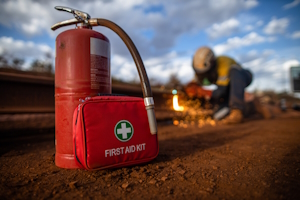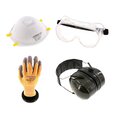The Importance of First Aid Training in the Industrial Sector

Figure 1: First aid is a priority in every workplace.
Industrial first aid training is crucial for workers in the industrial sector because this environment often presents more risks due to the use of heavy equipment and dangerous substances. Having employees trained in first aid ensures they can respond to accidents and emergencies promptly and effectively. Such preparedness is critical in reducing the impact of injuries and can save lives. It also promotes a culture of safety and can help decrease the overall costs related to workplace incidents.
View our online selection of industrial first aid supplies!
Table of contents
Regulations
First aid regulations can differ significantly from one region to another. Employers and employees must know the specific legal requirements for first aid in their location. The following summarizes the regulatory systems concerning industrial first aid in some regions and countries.
United States
In the United States, the Occupational Safety and Health Administration (OSHA) sets and enforces standards to ensure safe and healthful working conditions. OSHA's guidelines for first aid, found in 29 CFR 1910.151, require that employers provide prompt first aid treatment for injured employees. In the absence of an infirmary, clinic, or hospital nearby, a person or persons shall be adequately trained to render first aid. Certain industries or workplaces with specific hazards may have additional regulations regarding first aid training and equipment.
European Union
Each member state of the European Union has its regulations. However, they all fall under the system designed by EU Directives, such as Directive 89/391/EEC. This Directive requires employers to take measures for first aid, fire-fighting, and the evacuation of workers. The specifics of training, equipment, and facilities are usually detailed in national legislation.
Netherlands
The Dutch Working Conditions Act (Arbeidsomstandighedenwet) describes what employers must do to ensure first aid is provided. This includes having a sufficient number of trained first aid responders, first aid materials, and facilities available.
Germany
There are various occupational safety and health laws in Germany, including the Occupational Safety Act (Arbeitsschutzgesetz) and the Accident Prevention Regulations (Unfallverhütungsvorschriften). The German Social Accident Insurance (DGUV) has regulations on first aid in the workplace, specifying the number of first aid responders required based on the number of employees and the type of workplace.
France
In France, the Labour Code (Code du travail) describes employer obligations for first aid. The French National Research and Safety Institute (INRS) provides guidelines and training for first aid in the workplace.
South America
Like the European Union, countries across South America have their regulations regarding first aid in the workplace. Many countries have regulatory bodies similar to OSHA in the United States. In Mexico, for example, regulations are overseen by the Secretariat of Labor and Social Welfare (STPS).
First aid standards
While specific first aid regulations can vary across different countries, there are several general requirements that many countries' regulations share regarding first aid in the industrial sector. Here is a list of common first aid regulations found globally:
- Availability of a first aid kit: Most regulations require that a suitably stocked first aid kit for industrial use be readily available at the workplace.
- Access to emergency equipment: Emergency equipment includes items such as automated external defibrillators (AEDs), eye wash stations, and emergency showers, especially in environments where there is a higher risk of certain types of injuries.
- Trained first aid responders: Industries are often required to have a certain number of employees trained in first aid on-site during working hours.
- First aid training: Regular training and certification for first aid responders are commonly mandated, with the frequency and level of the industrial first aid course depending on the workplace risks.
- Recording and reporting: Keeping records of first aid treatment and incidents is typically required, along with reporting serious incidents to relevant authorities.
- Emergency procedures: Having clear, written emergency response procedures that employees are familiar with is often a standard requirement.
- First aid room or facility: Depending on the size of the facility and the number of employees, a dedicated space for first aid may be required. This space should have an industrial first aid cabinet.
- Regular review and audits: First aid equipment and procedures should be reviewed regularly to ensure they are up-to-date and effective.
- Risk assessment: Conduct regular risk assessments to tailor first aid provisions to the specific needs and potential hazards present in the workplace.
- Communication: Clear signage and communication about first aid points, personnel, and equipment are commonly mandated for quick and easy access during an emergency.
First aid training
In industrial settings, first aid training addresses specific injuries and health emergencies in such environments. Because of the higher risks in industrial work, training programs often go beyond basic first aid to include specialized modules. The following is an overview of the typical components of first aid training programs for industrial settings:
- Basic life support (BLS): Training typically begins with BLS skills, including cardiopulmonary resuscitation (CPR), using an automated external defibrillator (AED), and managing airway obstructions.
- Injury response: After BLS, trainees must learn how to respond to various injuries, such as cuts, abrasions, fractures, sprains, and burns. Trainees learn how to use bandages, splints, and burn dressings.
- Hazard-specific training: After general first aid training, first aid responders must know how to respond to other emergencies specific to their environment. These emergencies can include hazardous chemicals, electrical injuries, or thermal burns.
- Emergency action plans: First aid trainees must also know their site-specific emergency action plans, including evacuation routes, muster points, and communication protocols.
- Incident command system (ICS): In large industrial operations where a major incident may occur, first aid responders will be trained in ICS, which helps combine their efforts with those of professional emergency responders.
- Personal protective equipment (PPE): First aid trainees will learn the proper use of PPE, especially PPE used when administering first aid, such as gloves, masks, eye protection, and respirators.
- Scene assessment and safety: First aid trainees learn to assess how safe a scene is to ensure their safety and the victim's safety.
- Triage: In the case of multiple casualties, first aid responders must be trained in how to prioritize victims based on the severity of their conditions.
- Reporting and documentation: First aid trainees learn how to properly report and document incidents and responses.
- Stress management: In some programs, first aid trainees may learn how to manage their stress and the potential emotional repercussions of dealing with workplace accidents.
- Practical drills and simulations: To reinforce learning, training often includes practical drills and simulations that mimic real-life industrial emergencies.
- Refresher courses: Since skills can fade over time, industrial first aid training regiments usually require periodic refresher courses to maintain proficiency.
FAQs
What should be in an industrial first aid kit?
Local regulations determine specifics about what should be in an industrial first aid kit. Typical requirements are bandages, gauze pads, scissors, splints, and more.
Who should have industrial first aid training?
Every worker should know basic first aid. But it's most important for safety officers, emergency teams, and workers in dangerous areas to get full first aid training.







